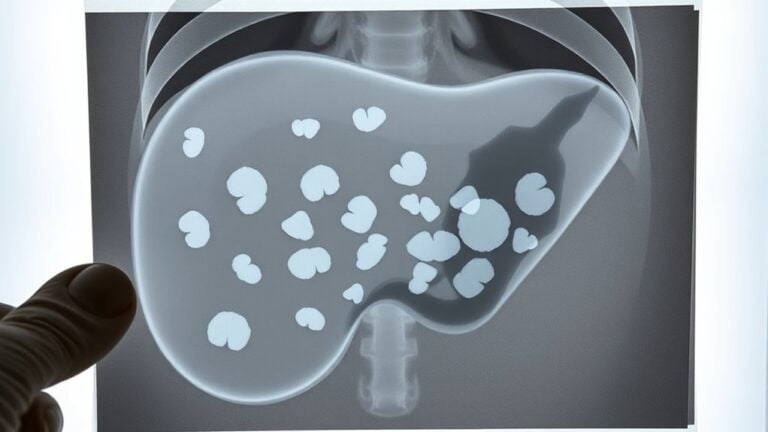Pleural effusion happens when liquid amasses between the layers of tissue lining the lungs and chest cavity, making it harder to breathe. Causes range from heart failure and infections to cancers and autoimmune diseases, each sparking liquid accumulation for diverse reasons. Some people feel sharp chest pain or persistent coughing, while others notice only mild discomfort or shortness of breath. Physicians employ imaging or liquid samples to pinpoint the underlying issue, and treatments vary—sometimes requiring drainage, medications, or even surgery. Comprehension of these signals at the outset can help manage the condition before it deteriorates, raising questions about which approaches work best for different instances.
What Is Pleural Effusion?
Many people experience pleural effusion without realizing it initially, since symptoms aren’t always obvious. Pleural effusion occurs when excess fluid accumulates in the pleural space—the thin gap between the lungs and chest wall. Normally, a small amount of pleural fluid lubricates the lungs, but when too much builds up, it can press against the lung, making breathing difficult.
Some might feel chest pain, especially when taking deep breaths, or notice shortness of breath. Others could have a dry cough or mild discomfort. The cause varies, but the problem isn’t the fluid itself—it’s often a sign of another condition affecting the heart, lungs, or elsewhere. Without treatment, fluid buildup can worsen, so recognizing timely symptoms is key.
Common Causes of Pleural Effusion
Because the pleural space can fill with fluid for many reasons, being aware of the common causes assists in identifying the basic issue. Congestive heart failure often leads to pleural effusion when pressure builds in blood vessels, forcing fluid leakage into the chest cavity.
Lung cancer and other tumors can block fluid drainage, creating a buildup that presses on the lung and chest. Infections like pneumonia inflame the pleura, worsening fluid retention and occasionally causing difficulty breathing.
Liver or kidney disease can also trigger effusions by altering protein levels, allowing excess fluid to seep into the pleural space. Injuries, blood clots, or autoimmune conditions like rheumatoid arthritis can contribute too. Recognizing these common causes helps pinpoint the root problem, guiding treatment to address the source of fluid accumulation.
Recognizing Symptoms of Pleural Effusion
How can someone determine whether they have pleural effusion? The symptoms often depend on the amount of fluid buildup between the lung and chest wall. Common signs include chest pain, especially when breathing deeply, and shortness of breath due to reduced lung expansion. A dry cough or fever may also occur if an infection is the underlying cause. Some people, however, feel no symptoms, with the condition only detected during a physical examination or imaging.
| Symptom | Possible Cause | When to Seek Help |
|---|---|---|
| Chest pain | Fluid pressing on lung | If sharp or worsens |
| Shortness of breath | Reduced lung function | With minimal activity |
| Fever | Infection-related effusion | Persistent or high fever |
A doctor may notice dull sounds when tapping the chest or decreased breath sounds, suggesting pleural effusion. Recognizing these indications early helps address the root cause.
Diagnostic Tests for Pleural Effusion
As symptoms suggest a pleural effusion, doctors rely on several tests to confirm the diagnosis and find the cause. A chest x-ray is often the initial step, showing the presence and size of the fluid buildup.
Ultrasound imaging helps visualize smaller or loculated effusions, guiding further procedures. Computed tomography (CT) scans provide detailed images, revealing potential underlying causes like infections or tumors. Thoracentesis removes fluid for analysis, determining if it’s caused by infection, cancer, or other conditions.
If the cause remains unclear, a pleural biopsy may be necessary to examine tissue samples. These diagnostic tests work together to pinpoint the issue, ensuring targeted care. Prompt and accurate testing helps manage the condition effectively, easing uncertainty for patients.
Treatment Options for Pleural Effusion
Several treatment options exist for pleural effusion, depending on its cause and severity. The goal is to remove excess fluid, address the underlying issue, and prevent recurrence.
- Thoracentesis: A needle is inserted to drain fluid (fluid aspiration), relieving pressure and aiding lung expansion.
- Diuretics: These medications diminish fluid buildup, often used for heart-related effusions.
- Antibiotics: Prescribed if infection is the cause, like in bacterial pleurisy.
- Pleurodesis or surgery: For recurrent cases, pleurodesis seals the pleural space, while video-assisted thoracoscopic surgery removes stubborn fluid or repairs tissue.
A chest tube may be placed for prolonged fluid drainage. Monitoring guarantees the effusion doesn’t return, and treatments are adjusted as required. Prompt intervention improves outcomes and comfort.
Conclusion
Like a clogged filter struggling to drain, pleural effusion slows the rhythm of breathing. John, a retired firefighter, described the frustration of feeling liquid-heavy lungs after battling pneumonia—each shallow breath a tiny rebellion against the fluid’s grip. His recovery, like clearing blocked pipes, required patience and targeted care. Whether caused by illness or injury, addressing both symptom and source offers the best chance for air to flow freely again.





